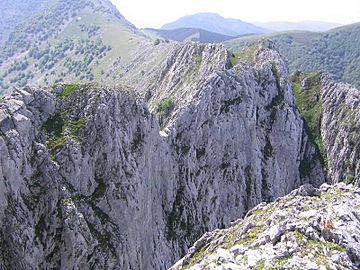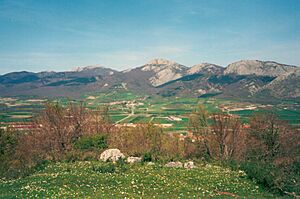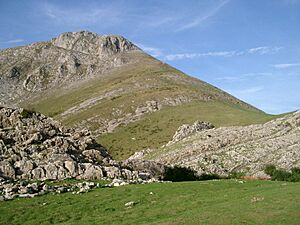Basque Mountains facts for kids
Quick facts for kids Basque Mountains |
|
|---|---|

Alluitz, a typical limestone mountain in the Basque range.
|
|
| Highest point | |
| Peak | Aizkorri |
| Elevation | 1,551 m (5,089 ft) |
| Geography | |
| Country | Spain |
| Parent range | Cantabrian Range |
| Geology | |
| Type of rock | limestone |
The Basque Mountains (called Montes vascos in Spanish, Montagnes basques in French, and Euskal Herriko arkua or "Basque arc" in Basque) are a mountain range in northern Spain. They are seen as the eastern part of the larger Cantabrian Range. These mountains stretch across the Basque Autonomous Community and western Navarre.
Contents
Exploring the Basque Mountains' Location
The Basque Mountains connect two other big mountain ranges. To the west, they meet the Cantabrian Range. To the east, they link up with the Pyrenees. Some scientists who study Earth believe that the Cantabrian Mountains and the Pyrenees are actually one huge range. They see the Basque Mountains as a special part that joins them together. This area is sometimes called "The Basque threshold" because it acts like a bridge between the two larger ranges.
How the Basque Mountains Are Divided
The Basque Mountains have two main parts that run side-by-side from west to east. One part is closer to the coast, and the other is further inland.
In between these two mountain lines, there is a flat, high area called a plateau. This plateau is about 500 meters (1,640 feet) high. It is known as the "Llanada Alavesa" (which means Alava Plains). The city of Vitoria-Gasteiz is located here.
East of the Llanada, you'll find a narrow valley. This valley is called Burunda and then Barranca (or Sakana in Basque). This valley separates two important mountain groups: Urbasa-Andia to the south and Aralar to the north. This valley is also home to major roads and railways. These links help connect Vitoria-Gasteiz and Pamplona.
Understanding the Climate in the Basque Mountains
The Basque coastal mountains act like a natural wall. They divide the weather patterns between the Mediterranean and Atlantic areas. North of these mountains, the climate is milder and more oceanic. This is typical of the region known as "green Spain" because it gets a lot of rain.
South of the coastal range, and in the inner mountains, winters are colder and often snowy. Summers are drier and hotter than in the northern parts. Generally, towns south of this range have a climate that is more like the Mediterranean with some continental features. This means less rain and much colder winters compared to the coastal towns north of the mountains.
Snowfall in the Mountains
Snowfall in the Basque Mountains can be very different from year to year. From November to April, you can find snow above 700 meters (2,300 feet) above sea level. However, the weather near the Bay of Biscay changes quickly. It can bring heavy snow, but then a sudden rise in temperature can melt it all in just a few days. This happens because of a special wind called the Foehn wind. This fast melting can cause flooding, especially in the plains of northern Alava.
Tallest Peaks and Mountain Groups
The Basque Mountains are not extremely high. The tallest peak is Aitxuri (1,551 meters or 5,089 feet). It is part of the Aizkorri mountain group.
Inner Mountain Groups
Here are the main mountain groups in the inner range, from west to east:
- Sierra Salvada near Orduña.
- The Mountains of Vitoria. The most important peak here is Kapildui (1,177 meters or 3,862 feet).
- Izki.
- Urbasa, which is a high, flat area about 900 meters (2,953 feet) tall.
- Andía, home to the impressive Beriain peak (1,493 meters or 4,898 feet).
Coastal Mountain Groups
These are the main mountain groups in the coastal range, from west to east:
- Gorbea (or Gorbeia), which is 1,481 meters (4,859 feet) high. It is the tallest point in Biscay.
- Urkiola, with Anboto (1,331 meters or 4,367 feet) as its highest peak.
- Elgea.
- Aizkorri.
- Altzania, where the Aratz peak reaches 1,442 meters (4,731 feet).
- Aralar, famous for its peak Txindoki (1,346 meters or 4,416 feet).
Nature and Wildlife in the Basque Mountains
The Basque Mountains are mostly made of limestone, a type of rock. However, you can find other kinds of rocks too. The mountain slopes are usually gentle and not too steep. But there are many limestone peaks and cliffs. These rocky areas are perfect homes for vultures.
The mountains have lots of plants that like an oceanic climate, which means plenty of rain. You'll see many beech trees, oak trees, and birch trees. There are also Cantabrian Holm Oaks. You might also spot Pinus radiata trees, but these were planted by people and are not native to the area.
See also
- Pyrenees
- Cantabrian Range
- Geography of Spain
 In Spanish: Montes vascos para niños
In Spanish: Montes vascos para niños



